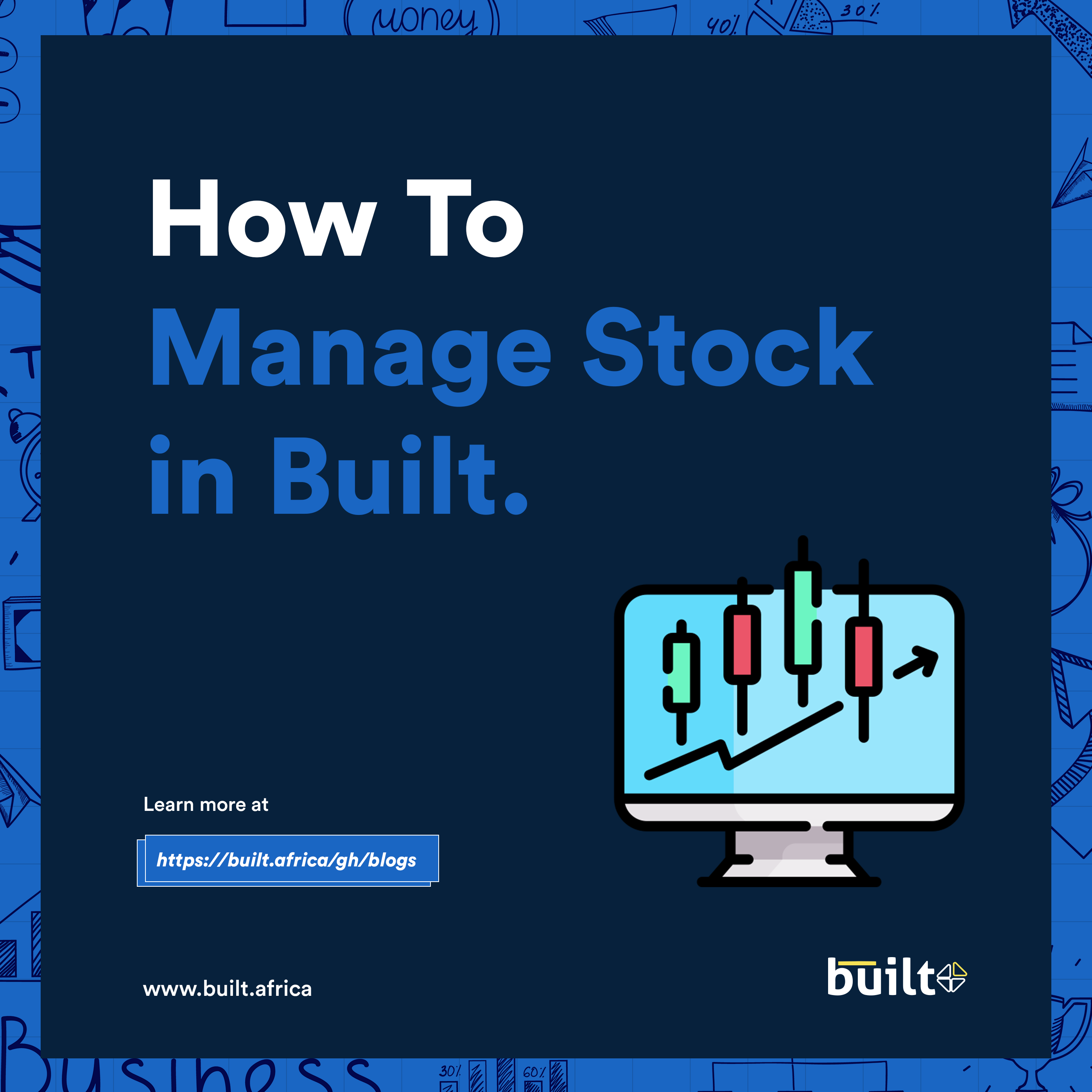
The built accounting software is an exceptional tool for managing inventory of business. With its amazing features, the application allows businesses to easily keep accurate records of their stocks. Enhancing proper inventory control at a lower cost. Stock management is a crucial aspect of any business. If stock is not managed effectively, it can cause financial losses. There are instances where a business sells one product to different customers, especially when customers make advance payments or deposits for goods they purchase. This inevitably lead to increase in unearned revenues, which the business must account for later. Consequently, although a business might seem to be doing well per its profit and loss statement. In reality, it will be drowning in debt if stock is managed poorly.
The built accounting software solves this problem and other challenges related to stock management, by enabling tracking and maintaining accurate inventory records. Here are the essential tools the built accounting software provides to help businesses effectively manage their stocks and ensure proper inventory control.
how to add product in built
Firstly, let’s learn how to add products to the software by following the steps below:
- Log in to your account using your user email and password.
- Navigate to the menu and select “Products and Services”. You will see the following display:
Top of Form

creating product categories in built
I. Item Categories: This feature allows users to group products and services based on specific criteria. Users can categorize their products according to factors such as their role in the production process, distinguishing between raw materials and finished goods. The distinction helps in effectively tracking the stock and ensuring proper inventory management.
II. To create an item category, go to the “Item Categories” section on the products and services dashboard. Click on “+ New category”. Enter the name and description for the category, and click “save” to confirm.
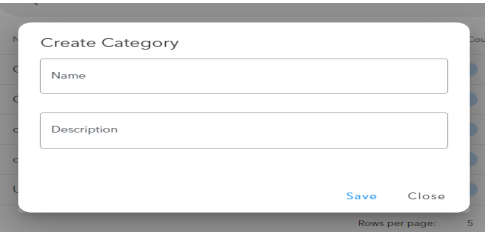
You can also click on the “three-action” button beside every category created to edit the details of the category.
Search: You have the option to search for a product or service by clicking the search button, entering the stock name and pressing enter and the product will be displayed for you.
creating a product or stock in built
- Add a product/service: You can manually add a product or service by clicking on the “+ Add A Product/Service” from the product and service dashboard. A pop-up box would appear as shown below.
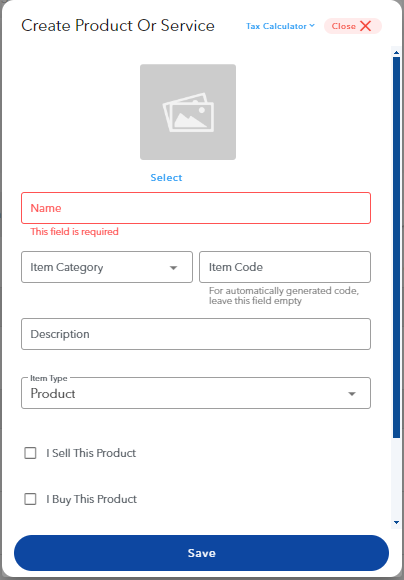
- Name: Enter the name of the product or service you wish to create.
- Item category: Select the item category of the product from the list of item categories created in the account.
- Item code: Provide an item code for the product or service if available, if not the system would automatically generate one for the item.
- Description: Add a description for the product or service you are creating.
- Item type: Click on the item type box to select whether it’s a product, service or fixed asset that you are creating.
- I Sell This Product: This feature specifies whether the item you are creating is intended for sale. If it is, toggle on the “I sell this product” button and enter the selling price for the item. If not, leave the button untoggled.
- I Buy This Product: This feature specifies whether the item you are creating is intended for purchases. If it is, toggle on the “I buy this product” button and enter the unit cost for the item. If not, leave the button untoggled. It is important to indicate that items which are bought to be sold should have both the I sell and I Buy this product toggled on with their respective selling prices and units costs.
- Track Inventory: You have the option to monitor inventory for any product you create. Simply activate the “Track inventory” button. Specify the initial stock number for the product, set the reorder quantity (the level at which the system should alert you to restock), and provide the date for recording the initial stock.
- Apply Taxes: Select the applicable taxes you want applied on your product or service to be created.
- After putting in the required information proceed to click on “Save” to save the product/service.
how to import products into built
- Import: This feature serves as an alternative for users with a lot of products and services to import a file containing their products and service list into built. This is shown in the image below.
To import a product/service, navigate to the product and service dashboard and click on “Import.” A pop-up window will appear as shown below. Download a sample Excel file by clicking on the “Download Sample File” link in blue.
A preview of the file is displayed below the sample file text. Populate the downloaded sample file with the list of your products and services details in the respective columns as illustrated in the excel sample. Save the file, return to the import page, select the populated sample file by clicking on “Select File,”. You will then click on “Upload” to import your products and services into your account.
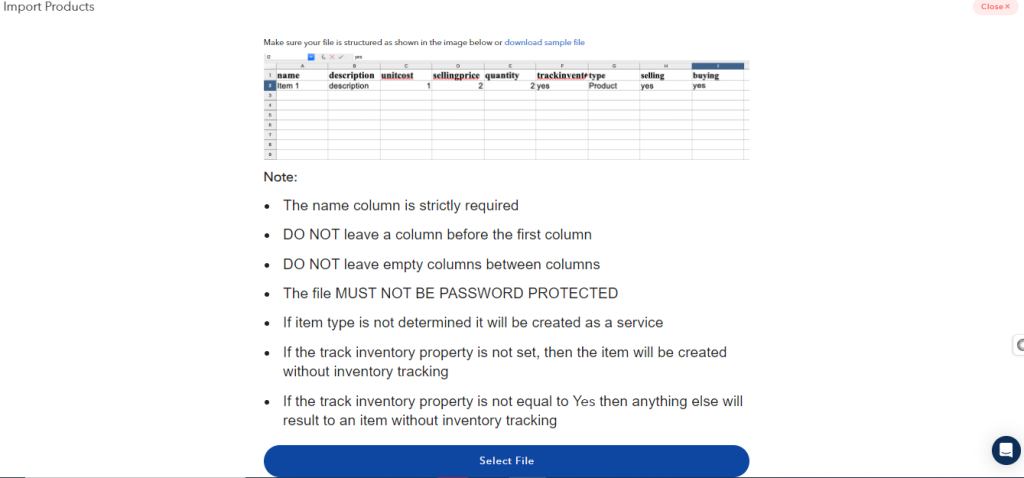
- Tax calculator: This is used to calculate the various taxes you need to apply on a product or service.
- Export: The export feature is used to either export the item list or barcode list of products or services.
You can also click on the “three dot action” button on the products and service dashboard beside each product created to edit, view details, record a sale or purchase and delete a product or service if there is no transaction attached to it.
adjusting existing inventory
Now that we have created our products, let’s now understand how to make adjustment to our existing product in the software by following the steps listed below. Adjustments include new purchases, converting raw materials to produced products, and reducing products as a result of damage or theft.
- On the product and service dashboard click on the product you want to adjust. You will see the display below.
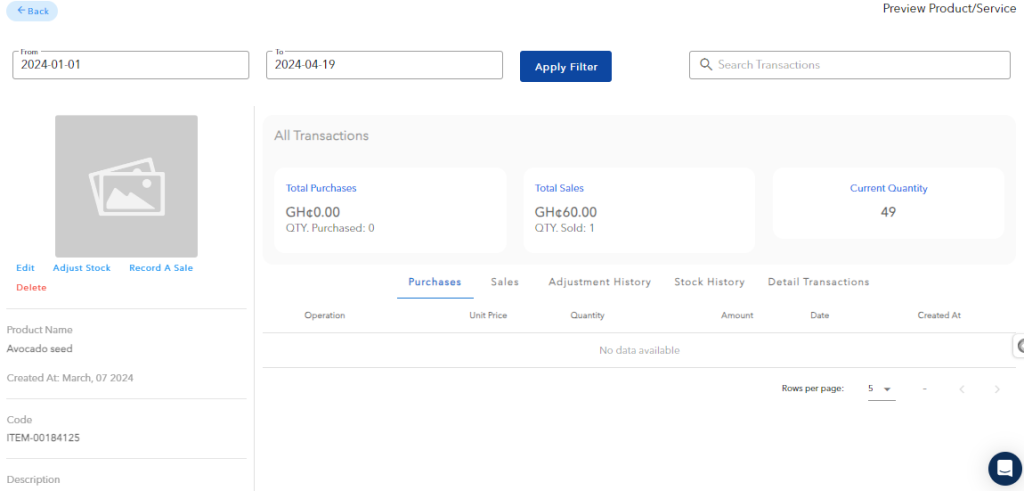
- Click on the “Adjust stock” button to get the following dashboard.
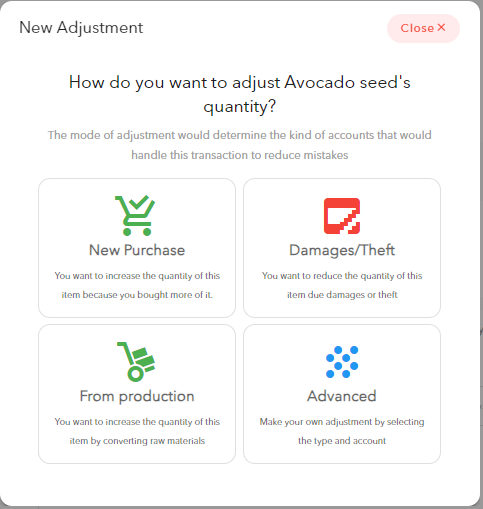
- New Purchase: The feature helps you record cash purchases of an existing product into the software. All credit purchases must be recorded with bills. Below is the dashboard of the new purchase feature. This feature should only be used when you have paid for the product.
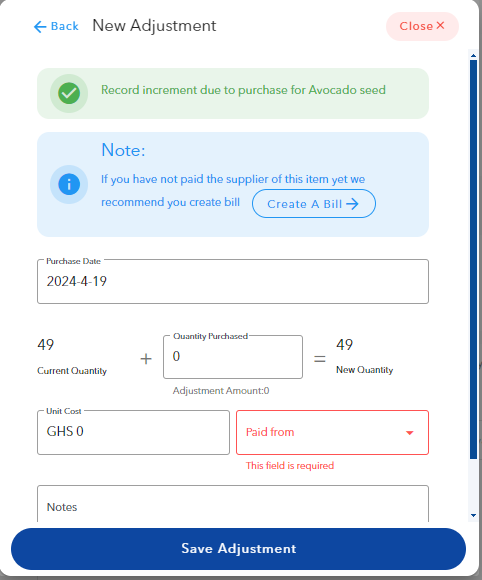
- Purchase Date: Select the date you made the purchase
- Quantity purchased: Input the quantity of products you purchased
- Unit cost: Input the cost per unit of the products you purchased
- Paid from: Select the payment method you used to pay for the products
- Notes: Enter the description of the transaction and save adjustment
- Damages/Theft: This feature helps you reduce your products in the system if the product is damaged or stolen, to prevent overvaluation of stock and ensure proper management of stock. Below is the display of the damages/theft feature.
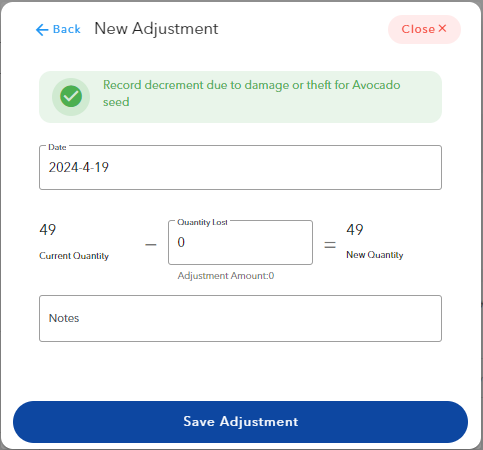
- Date: Select the date you are reducing the stock
- Quantity lost: Input the quantity of stock you are reducing
- Notes: Enter the description of the transaction and save adjustment
- From Production: This feature helps you increase the quantity of a product by converting a manufactured product or items that track inventory. This action will reduce the raw material in the system. Below is the display of this feature
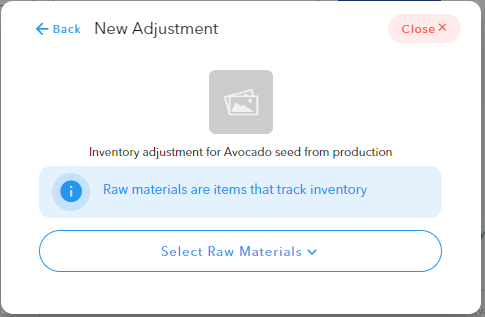
Kindly note that only items that track inventory can be selected as raw materials. So here click on select raw materials and you will see a display of you tracked inventory and select the item that you want to transfer. After that you will see the following display;
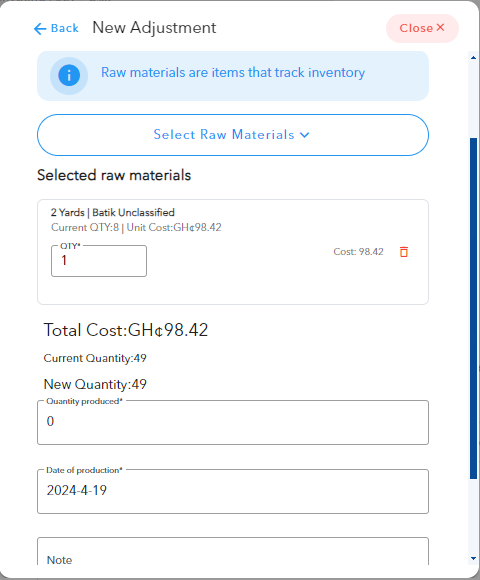
Select raw materials: Here you have the option to add other raw materials you want to convert into finished products.
- QTY: Input the quantity you want to convert.
- Quantity Produced: Input the equivalent quantity of stock that raw materials is used to produced, for example if you use fifty shear-nuts to produce two bottles of shear-butter, you will enter 50 in the “QTY” box and 2 in the “Quantity Produced” box.
- Date: Select the date you are converting the inventory.
- Note: Enter the description for the activity.
Effective working capital management is essential to the cashflow management of a business and its survival to some extent. The built accounting software helps with effective inventory management, which is essential to working capital management. Explore a variety of informative articles and stay updated with the rapidly evolving financial landscape!




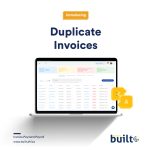




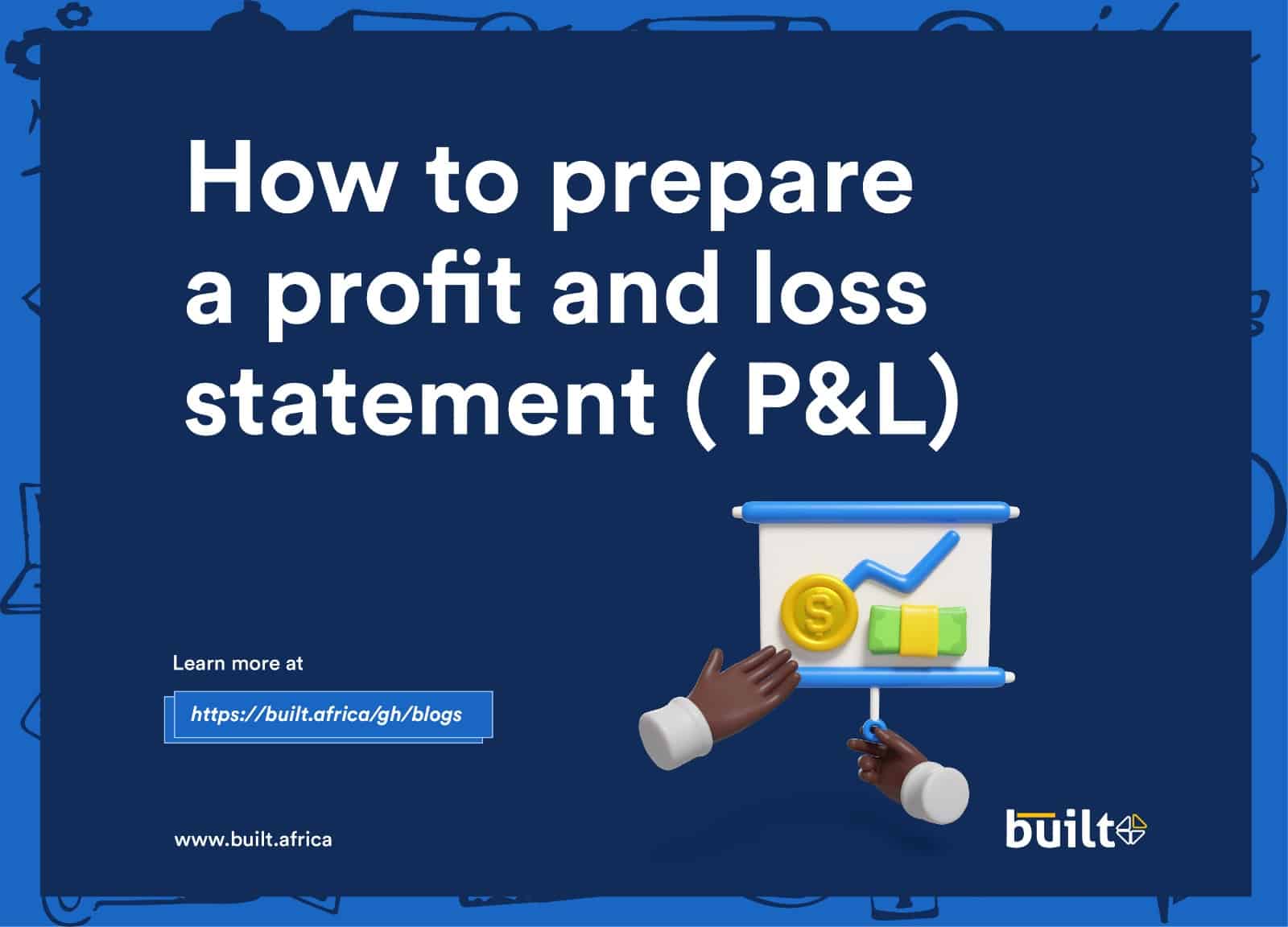


No Comments